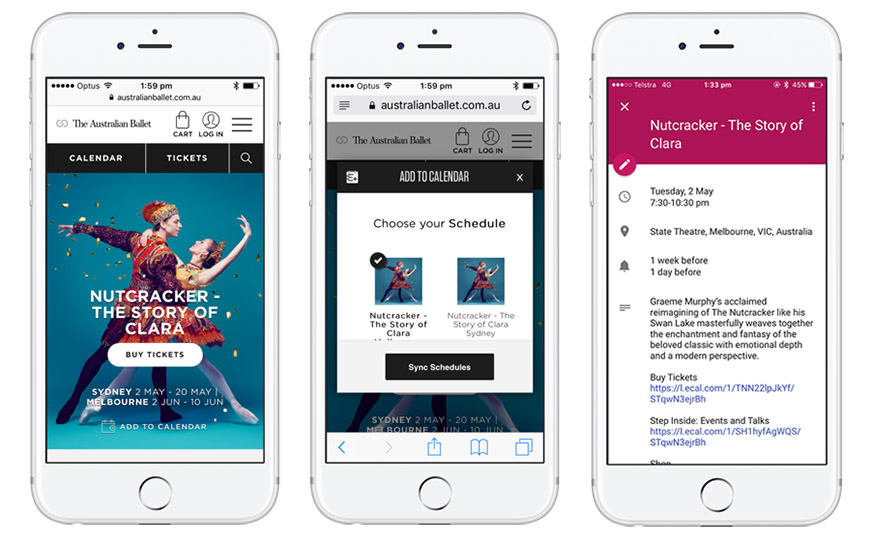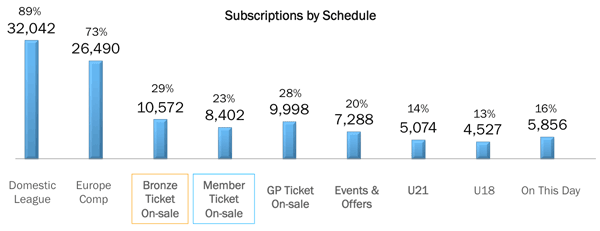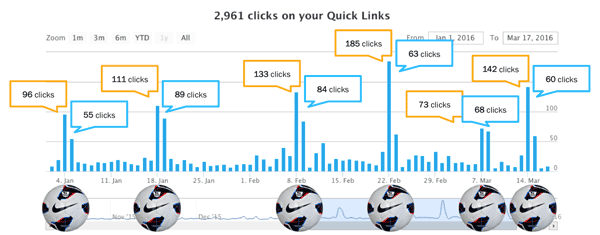Recognised as one of the world’s major international ballet companies, The Australian Ballet has launched its calendar-based community engagement, ticket sales and communications feature, powered by ECAL.
Launched in April 2017, ECAL’s ‘Add to Calendar’ enterprise technology is a key strategic initiative in the continued development of The Australian Ballet’s digital platform.
As well as being a wonderful service for season ticket holders, the feature also aims to better inform the more casual ballet enthusiasts, in order to drive stronger retail sales conversion.
The ‘Add to Calendar’ feature is found in multiple locations across australianballet.com.au. In the ‘event discovery’ phase, users can sync the entire ballet season in their favourite city directly from the master ‘Calendar’ page. At the production level, you can choose to sync your favourite productions, across your preferred cities.
In the ‘post purchase’ phase, users can also easily sync the events that they have bought tickets for, straight to calendar.
The ECAL feature is live and dynamic, and keeps users up-to-date with production details, with handy reminders and links to drive sales and engagement, including a direct link to ‘Buy Tickets’, all from their personal calendar on mobile or desktop.
ECAL’s enterprise ‘Add to Calendar’ solution enables The Australian Ballet to:
- Better service season ticket holders
- Acquire new customers
- Drive casual retail ticket sales
- Improve online engagement
- Promote interest in other ballet products and features, like Ballet TV

ECAL has extended the release of its cool new ticket alerts feature for the NBA. NBA fans who sign up to Ticketmaster alerts can select to receive their favourite NBA team ticket alerts for ‘all games’, or ‘just home games’.
NBA fans who sync the ticket alerts to their calendar receive timely ticket sale reminders, with direct links to ‘Buy Tickets’, ‘Resale Tickets’ and more.
NBA fans will never miss out on a chance to purchase a ticket again!
Who doesn’t love emojis!
These tiny, colourful collection of icons and feelings can make your events stand out in the calendar.
You can incorporate emojis into your ECAL events
For MAC
- Position the cursor in the field in which you’d like to insert the emoji (e.g. Match / Game Name)
- Press the Command, Control Keys and Space Bar to launch the characters palette
- Click on the Emoji icon in the palette you’d like to include.
On Windows
If you use Windows 8 or Windows 10, please follow the steps below.
- Activate the Touch Keyboard by clicking the keyboard icon in the lower-right corner of the taskbar.
- Click on the smiley face on the on-screen keyboard: the emoji keyboard will replace the regular alphabetical keyboard.
- Scroll through all the emojis using the left and right arrows on the left side of the keyboard, or clicking on the category buttons at the bottom of the keyboard. When you spot the right emoji, click on it and it will appear in your text field.
Published by Laurie Sullivan; MediaPost, 1st September 2016.
Organizers for COPA, the South American international men’s soccer tournament, wanted to catch the attention of soccer fans in the U.S., where the games were being held for the first time in the tourney’s 100-year history.
The global fan base also needed help tracking 32 matches across 10 cities with 16 teams, from June 3 through 26.
So COPA’s organizers used ECAL’s technology, which creates calendar-based digital marketing campaigns.
There are other calendar widgets, admits Patrick Barrett, CEO at ECAL, but he says his company provides data, targeting and tracking. “The calendar notification can completely bypass the email box,” he said.
The goal for COPA meant creating awareness and anticipation for the U.S. audience ahead of the Tournament Draw. It also was aimed at building a connected calendar audience of passionate fans, driving early and advanced ticket sales, and collecting profiled data for new fan acquisitions and conversations began in February 2016.
The campaigns required fans to opt in through a sync-to-calendar button on the brand’s Web site. The technology integrated across Facebook, Web sites, calendars, even email.
The consumer chose the tournament schedule, and the technology populated the fan’s personal calendar, alerting them when a Tournament Draw became available.
A tracking URL in each link followed the consumer through the purchase. ECAL knows how much consumers spent, when they made the purchase, and in which category it was purchased.
Before the tournament was announced, there were more than 53,000 calendar subscribers.
The campaign drove total registration of 91,470 consumers; opt-in rate of 73%; active users of 59,456; and an active user rate of 65%.
Overall, the campaign drove 17,201 click-throughs, at a 0.68% click-through rate.
The emerging channel drove $90,042.36 in sales, with an average order value of $441.38. COPA earned fan preferences in event times, ticket purchasing, merchandise, TV vs live attendance, interaction, opt-ins and more at an average CPM of $20 and cost per click of $5.
View the article here

By Eric Fisher, Staff Writer
Published July 18, 2016
eCal, an Australian developer of calendar-based digital marketing products, has struck a multiyear deal with the EPL to develop the “Premier League Digital Calendar.” The product will allow fans to sync team schedules, local broadcast details, ticketing links, and other match-related data into their digital calendars, either on desktop or mobile. The calendar-based platform then communicates to fans a variety of reminders for match times, ticket on-sale dates, last-minute seat availabilities and other related messages. The EPL deal, nearly a year in development, represents a substantial increase in scope for eCal, which works with more than 300 sports and entertainment clients, including the Patriots, Redskins, Celtics, Pacers and MLS. “This is a really important deal for us,” said eCal Founder & CEO Patrick Barrett,. “You’re obviously talking about one of the leading sports leagues in the world, and this is one that really shows how sports organizations are really beginning to budget for calendar-based marketing.” Financial terms were not disclosed, but the deal is a vendor-based contract. The eCal digital calendar product will be included in the EPL’s mobile apps in time for the beginning of the ’16-17 season next month, and will be available in 14 different languages.
Patrick Barrett, Founder & CEO, ECAL.com
In an increasingly fragmented media landscape, personal and profitable interaction with consumers can feel like a marketing goal that’s just within reach and at the same time as elusive as the Holy Grail.
The introduction of each new communications channel presents an opportunity to finally reach that goal. Yet, even with the unprecedented popularity of highly interactive social media, it has been difficult for most organizations to foster direct connections that convert to profitable action.
Like many innovations, the solution behind ECAL now seems deceptively simple, but achieving it required the patience to nurture an idea and the ability to recognize when technologies had finally aligned to support it.
To turn the introduction of this new tool into an award-winning marketing product with global appeal, we followed a simple three-step strategy.
Identification strategy: The critical first step to identifying market need and opportunity
It was 2001—no one was talking about working “in the cloud” and cell phones weren’t yet “smart.”
I was a sports marketing professional finishing a successful major rebranding campaign for the British Horseracing Authority in London. We used the new consumer website to augment traditional advertising methods, but the inefficiency of printing and mailing track schedules left me wishing for an easier way to share the most up-to-date information with fans.
That seemingly tiny niche market need actually set me on course to develop the first online scheduler that would sync events into a personal calendar.
While it was sports organizations like the British Horseracing Authority (UK), Major League Soccer, New England Patriots (US) and Hawthorn Football Club (Aus) that first recognized the value of the technology, their early adoption established a need and an even wider market for the product.
Engagement strategy: Breaking through the missing piece in the market place to connect with the customer
The best solution isn’t always the one that seems the most obvious. To find that missing piece of the engagement strategy puzzle, we had to look beyond traditional advertising paradigms.
Each hot new social media channel has been targeted by advertisers because of the highly interactive nature and widespread adoption of these sites. But each new social media channel is simply another media channel, ultimately serving only to further fragment the advertising landscape. According to Smart Insights, ad CTR across all formats and placements is a disappointing 0.17%—less than 2 clicks per 1,000 impressions.
The same can be said of email—essentially the digital version of the stacks of direct mail consumers regularly toss directly into the trash. Consumers have been inundated with email to the point that major providers auto-sort email into pre-set folders, reducing the number of messages a consumer sees, much less opens. Remarkably, open rates on such emails can still average around 16%, but click-through rates have remained discouragingly low, around 1.3%.
Aside from email, there is another app that nearly every person on a desktop, laptop, tablet or mobile phone uses at least several times every day: the personal calendar. The average smart phone user checks their phone up to 150 times per day and 75% of consumers age 18 to 64 report that they rely upon their digital calendar to manage their life schedule.
Being able to book a piece of time directly into a consumer’s personal calendar is an incredibly powerful marketing tool that had never been used to its full potential.
With calendar marketing, brands place the power of content selection into the hands of the consumer, who chooses what they want to see in their personal calendar—sports and entertainment schedules, special offers, even payment reminders—so content relevance to the consumer is nearly 100%. For comparison, the scattergun approach of email marketing is available to anyone who may come across your email address, and may deliver 15% to 20% content relevancy.
Consumers choose to sync an organization’s content to their own personal calendar, delivering not only increased sales and loyalty, but which also works to ‘self-profile’ your audience and provide invaluable contact and preference data that can be used to deliver better communications and make smarter business decisions.
Built as an enterprise-level system to augment any marketing automation suite, ECAL clients own and maintain control of their customer data, and access further insights from behavioral analytics. And that data is rich, working to fuel a more ‘dynamic’ CRM framework. As a valuable CRM component along the entire ‘customer journey’, the ECAL technology contributes to all stages of the value chain, from acquisition to engagement, monetization, and loyalty.
Defining niche: Few products can be all things to all people
Developing a strategy to right-focus a solution to a particular market pain is crucial. By entering the market with a niche focus, ECAL was able to establish a clear market need and demonstrate the platform’s usefulness across a spectrum of industry verticals.
Early adopters have given rise to significant global brands adopting ECAL as a key element of their digital marketing strategy, including Live Nation (Ticketmaster), Copa America and Premier League. Enterprise clients of ECAL are experiencing up to 90%+ opt-in rates, 70%+ mobile subscriptions rates, 84% new customer acquisition, and increases in revenues driven by consumer responses that have effectively doubled the normal ‘purchase rate’ for some brands, especially for tickets.
The experiences of the early adopters helped prove the wider market value of communications targeted directly into personal calendars. For any organization looking for a deeper relationship with its customers, partners, and others, the use cases go well beyond the original sports schedule niche market: education, retail, transactional, and media, to name a few.
Published by Logan Bradley; SportTechie, 5th July 2016.
Everybody has signed up for an email list at one point in their life and regretted it, it’s almost like a rite of passage. You end up deleting the majority of the messages you get and receive almost no benefit from subscribing.
In fact, according to Patrick Barrett, the CEO of ECAL, email open rates are as low as 5%. That’s why Barrett came up with the idea of delivering user-specific content directly to the consumer’s calendar. “Communications are always seen at the right time through the alerts and reminders that you set through the calendar,” said Barrett. “As opposed to hoping or waiting for someone to open their email.”
The goal of ECAL is to “beat the inbox,” as Barrett puts it, and to be able to communicate to their consumers when it’s most appropriate about the things that are most relevant. One of the reasons you will get content that is most relevant to you is because nobody knows your calendar address like they do your email. Due to this, nobody can spam you, and only you can control what information you select to have sent to your calendar.
ECAL works with a variety of leagues including the recently concluded COPA competition. “We delivered the digital match calendar for COPA,” said Barrett. “That was a very key tool for COPA in its business strategy.”
One of the key things that ECAL was able to do for COPA was build an audience for them very quickly, even before the tournament draw was released. Fans were able to choose their favorite team and have their entire schedule synced straight to their personal calendar. They also provided additional incentive for people to download the calendar by offering a chance to win two tickets to the official COPA draw in New York City.
That’s not all that ECAL offers through its partnership with multiple leagues and tournaments like COPA. They also provide the ability for fans to buy tickets in advance of their favorite team’s game. According to Barrett, through the use of the COPA ECAL, over $83,000 worth of tickets were bought.
COPA isn’t the only large soccer enterprise that ECAL associates with, they also just recently (June 15) launched the Premier League digital calendar. “What’s really important about that (the partnership) is that big brands like Premier League, COPA, MLS and others have calendar marketing as a key part of their marketing mix,” said Barrett.
Clients like the Premier League own the rights to the customer data that they get through the use of ECAL. They have instant, real-time access that they can sort and use to their benefit.
ECAL is based in Australia and works with pretty much every major league there, as well as in New Zealand. In the U.S. they work with Major League Soccer along with teams like the New England Patriots and Washington Redskins of the NFL and theBoston Celtics of the NBA. Given the globalization of ECAL, they do displays in 14 different languages by using widgets that have geo-detection technology to serve every market.
However, their biggest client in the U.S. isn’t a sports team, it’s Ticketmaster. “If you look at the Ticketmaster site for the U.S. now, every event for the U.S. has an ECAL enter calendar link on it,” explained Barrett.
He also said that partnering with Ticketmaster has pretty much doubled their purchase rate from tickets in the calendar.
The days of mindlessly sifting through emails in search of something relevant to you is over. Get exactly what you want and care about directly to your personal calendar with ECAL.
View the article here
Sports fans are interested in more than just your season schedule. Sure, that is the number one reason why fans will subscribe to your ‘digital calendar’, however you best not stop there!
The average sports client on the ECAL platform promotes around 5-6 ‘schedules’ of content, and that can offer a nice broad selection of content – including various game schedules, broadcast schedules, corporate events, community program events, and events for special interest groups (eg: Women’s networking, cheerleaders or coteries).
Additionally, as fans choose their schedule preferences, they effectively self-profile. This will help you develop a 360-degree view of the customer, and help fuel a more ‘dynamic CRM’ framework. It will ensure any further communications you send to a customer is tailored to meet their specific interests.
Leading sports brands like Tottenham Hotspur FC and Washington Redskins have as much as a dozen schedule choices, with good reason.
By offering a selection of great content, you allow your audience to keep up-to-date with events that specifically interest them – events they likely didn’t know existed in the first place. These top brands are also using content schedules to prompt sales interest, with schedules for ‘Ticket On-Sale Dates’ proving hugely effective.
To demonstrate the point, here below are the schedules offered by an ECAL football client, and the percentage of users who subscribe to each schedule. There are a total of 38,000 subscriptions in total at the time.

As you can see, 29% of users subscribe to ‘Bronze’ category ticket dates, 23% to ‘Member’ ticket dates and 28% to ‘General Public’ ticket dates. Additionally, 20% are interested in ‘Events & Offers’.
Now let’s look at exactly how these ticket on-sale dates stimulate click-throughs and purchase intent straight from the calendar.

You can see distinct ‘click-through’ peaks generated specifically by the ‘Bronze’ and ‘Member’ ticket on-sale entries appearing in the fans’ calendar.
These ticket on-sale date entries let fans know exactly when they can purchase tickets for upcoming games, with instant and direct access to purchase tickets via embedded links. Timely reminders are set beforehand, so the fan has time to consider and prepare to engage, and purchase.
As you can see, fans are interested in so much more than just the games! The calendar is a very powerful channel to stimulate buying intent for tickets, and for other high value sales like season tickets, merchandise / team gear, online video subscriptions, Christmas gift ideas and more.
It is often asked, around our office at least…”if it’s not in my calendar, does it even exist at all?” Indeed we hear the same sentiment from ECAL users time and time again.
So, the benefits of communicating to the calendar seem to make great sense, right? Avoid the inbox chaos, deliver your message to users, at the ‘right time’, in the ‘right place’. Makes total sense.
And we know that the modern consumer is increasingly mobile, they are always connected to the internet, they are forever “busy”…so “busy”, and managing life is hard enough!
So how does the modern consumer keep on top of it all? Exactly to what extent do they rely upon their ‘digital calendar’ to manage “life”. Exactly how many manage life via their personal digital calendar, compared to say, keeping a wall calendar, a diary or journal?
Well, we have the answers!
We surveyed 1,000 people (aged 18-64) in each of the US, UK and Australia. The sample was representative of the population.
The Question: What do you rely upon most to manage your daily schedule?
United States

United Kingdom

Australia

Some further insights reveal that:
* In UK, over 62% of 18-14 year-olds use their mobile calendar
* In Australia, 25-34 (59.5%) and 18-24 (57.7%) year-olds are most likely to use their mobile calendar
* In US, 63% of 55-64 year-olds use a digital calendar (mobile or desktop) rather than paper (37%)
* Women use paper diaries / journals / planners more than men

By Chris Smith, Forbes, June 10, 2016

Next week the Premier League will at long last unveil its 2016-17 league schedule. It’s a much-anticipated occasion, which is perhaps best highlighted by the number of rumored schedule leaks (and the flood of accompanying headlines) that have hit the internet in recent weeks. But what’s truly different this time around is that the English league will be putting a new twist on its schedule reveal: Thanks to a new partnership with ECAL, an interactive calendar marketing platform, fans will now be able to add the fixtures to their calendars with just a few clicks.
“We started to think about the personal calendar space as a new communications channel,” says ECAL founder and CEO Patrick Barrett, “and what we’ve found is it’s an incredibly effective method of communication.”
What does that mean for fans? ECAL’s technology will allow soccer fans to instantly sync the Premier League’s schedule with their personal calendars, no matter whether they use Outlook, Google GOOGL -1.27% or mobile calendars fromApple AAPL -1.06% and Android. In addition to adding game dates to their calendars, fans will also be able to schedule league events, important dates and even buy game tickets. Barrett notes that bypassing the inbox provides “100% delivery,” and the content is totally relevant – “the content choice is in the hands of the consumer.”
Though next week’s schedule reveal will mark the start of ECAL’s league partnership, it won’t be the company’s first step into English soccer. Last season Tottenham Hotspur partnered with the company, and that relationship offers a good idea of what Premier League fans will have in store. Go to the London team’s schedule page and you’ll find the option to sync to your calendar:

Clicking that button offers nine different schedules to add to your calendar, ranging from match days to ticket on-sale dates to even an “On This Day” option. Barrett notes that while game dates are obviously the most subscribed to, those other options are surprisingly popular. Last year ticket on-sale dates were subscribed to by 40% of users, while club events garnered around 30%.
And English soccer fans aren’t the only sports nuts who can benefit from ECAL’s technology. Barrett says the company currently does more business in the US than anywhere else, and it counts the New England Patriots, Washington Redskins, Boston Celtics and Columbus Blue Jackets among its partners (plus major college athletic programs like Duke and Notre Dame). The USGA has joined on, and the NHL has used ECAL for its postseason schedule. Major League Soccer is also a partner, as are all 20 teams – great news for ECAL, which counts each team as an individual account.
“We’re seeing incredible metrics,” says Barrett of measurements like click-throughs and purchases, and a recent test run for this summer’s Copa America backs that claim up. ECAL leveraged its MLS deal to partner with the international soccer tournament, and earlier this year the company ran a single-match test. In the space of a month the tournament picked up 53,000 ECAL subscribers and sold more than $63,000 in tickets for that single match.
Perhaps the best news for teams and leagues is that ECAL’s technology grants direct fan engagement while remaining eminently affordable. ECAL receives a base monthly fee – pro sports teams and leagues fall into the enterprise category of the company’s pricing, which typically means a fee in the range of $400 per month – and then additional fees scale according to usage, essentially at a few pennies per user.
All told, for even a popular team like Tottenham the annual cost comes in at less than $10,000 per year, hardly a tough price to pay for the team with revenues of $310 million. And the payoff? Tremendous. Thanks to thousands of impressions, click-throughs and ticket sales, Barrett says that brands have returned anywhere from 30- to a staggering 300-times their investment.
View the article here: https://ow.ly/apq03018yE7

